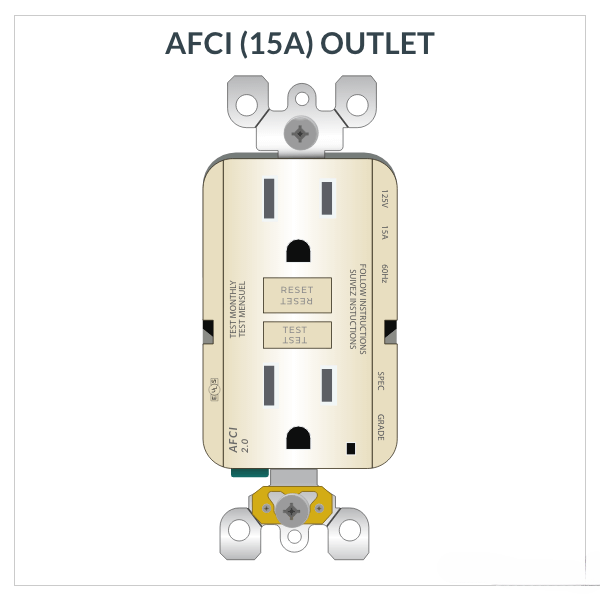Introduction: Keeping Your Home Safe from Hidden Electrical Hazards
Our homes are sanctuaries, places of comfort and relaxation. But lurking beneath the surface, a hidden danger can threaten that sense of security: electrical arc faults. These may sound like something out of a science fiction film, but they’re a very real electrical issue with the potential to cause serious damage. The good news? There are ways to protect yourself and your home. In this blog post, we’ll unravel the mystery of arc faults, explain the risks they pose, and introduce a superhero in the fight for electrical safety – the AFCI outlet. So, grab a cup of coffee, settle in, and let Good Sense Electric illuminate the path to a safer home.
What are Arc Faults? Understanding the Electrical Sparks in Your Walls
Imagine electricity as a well-mannered guest in your home. It follows a designated path, powering your lights, appliances, and electronics. But sometimes, things can go awry. An arc fault is like an unruly guest, one that decides to take a shortcut instead of following the designated path.
In simpler terms, electrical current ideally flows smoothly through wires. This smooth flow is essential for safe operation of your electrical system. However, arc faults disrupt this harmony. They occur when the current jumps between unintended points in the wiring, creating sparks or arcs. Think of it like a tiny electrical explosion happening within your walls – not exactly the kind of houseguest you want!
These arc faults can be caused by a variety of culprits. Loose connections at outlets or switches, where wires aren’t securely fastened, can create an opportunity for current to jump the gap. Similarly, damaged wiring, perhaps from wear and tear or rodent chewing, can expose live wires and increase the risk of arcing. Overloading a circuit by plugging in too many appliances can also create an environment where current seeks unintended paths. And let’s not forget faulty appliances with internal wiring issues – they too can become a source of arc faults.
The Dangers of Arc Faults: Why They Deserve Your Attention
Arc faults might seem like tiny electrical hiccups, but don’t underestimate their potential for serious trouble. The most significant danger associated with arc faults is the risk of fire. The high temperatures generated by those sparking arcs – thousands of degrees in a split second – can easily ignite nearby combustible materials within your walls, ceilings, or even behind furniture. A single, unnoticed arc fault has the potential to become a full-blown fire, jeopardizing your home and loved ones.
It’s important to note that arc faults aren’t just fire hazards. While less common, they can also pose a risk of electrical shock if a person comes into contact with a faulty wire during maintenance or repairs. Additionally, the intense heat from an arc fault can damage electronic equipment plugged into the affected circuit, leading to costly repairs or replacements.
Here at Good Sense Electric, our priority is your safety. While we don’t want to create undue fear, we believe in knowledge as the best defense. By understanding the dangers of arc faults, you can take steps to protect yourself and your home.
Identifying Arc Faults: The Challenge and the Solution
Unfortunately, unlike a flickering light bulb, arc faults aren’t always easy to detect visually. They often occur hidden within walls, behind electrical panels, or even inside faulty appliances. This makes identifying them a challenge for the average homeowner. So, how do we combat this invisible threat?
Enter the AFCI outlet, your silent guardian against electrical mayhem. These specially designed outlets act as a crucial safety measure by containing sophisticated technology that can detect the unique electrical signature of an arc fault. Unlike a standard outlet that simply reacts to a complete circuit overload, AFCIs can differentiate between normal current flow and the erratic pattern of an arc fault. When an arc fault is detected, the AFCI outlet takes swift action, automatically shutting off power to the affected circuit. This immediate response can prevent a potential fire from igniting, keeping your home and family safe.
While AFCI outlets are crucial for mitigating arc fault risks, it’s important to distinguish them from another safety outlet – the GFCI (Ground Fault Circuit Interrupter). GFCIs primarily protect against electrical shock hazards by detecting imbalances in current flow, often associated with a potential grounding issue. They are commonly found in areas with high moisture risk, like bathrooms and kitchens. AFCIs, on the other hand, specifically target arc faults and the unique electrical signature they produce. Both AFCI and GFCI outlets play essential roles in overall electrical safety, offering a layered defense against different electrical dangers.
It’s important to note that AFCI outlets occasionally trip due to reasons unrelated to arc faults. Perhaps a surge protector kicks in, or a sudden increase in appliance power draw momentarily disrupts the circuit. While a tripped AFCI outlet can be an indicator of an arc fault, it’s crucial not to attempt self-diagnosis or troubleshooting. If your AFCI outlet trips repeatedly, this is where the expertise of a qualified electrician becomes crucial.
Addressing Arc Faults: When Safety Demands Expertise
While AFCI outlets provide a vital layer of protection, it’s important to remember that electrical work requires specialized knowledge and experience. Arc faults can pose serious electrical hazards, and attempting DIY troubleshooting can put you at risk of shock or injury. The intricate wiring within your walls carries immense power, and even seemingly simple tasks like replacing an outlet can have dangerous consequences if not done correctly.
Here at Good Sense Electric, we have a team of qualified electricians who possess the expertise and experience to diagnose and address arc faults safely and effectively. Our electricians are equipped with specialized tools like arc fault detectors that can pinpoint the exact location of the issue within your electrical system. Safety is their top priority, and they adhere to strict safety protocols to ensure their own well-being and yours throughout the troubleshooting process.
Once the source of the arc fault is identified, our electricians will determine the most appropriate course of action. This may involve repairing faulty wiring, replacing damaged outlets or switches, or addressing overloaded circuits. They’ll work diligently to ensure the issue is resolved effectively and your electrical system functions safely and efficiently, giving you peace of mind and a safer home environment.
Preventing Arc Faults: Proactive Measures for a Safer Electrical System
While arc faults can be a concern, there are proactive steps you can take to minimize the risk in your home:
- Avoid Circuit Overloading: Be mindful of how many appliances you plug into a single circuit. Overloading a circuit creates stress on the wiring, increasing the chance of loose connections and potential arc faults. If you find yourself constantly needing to unplug one appliance to use another, it might be time to consider adding a new circuit to your electrical system. Our qualified electricians at Good Sense Electric can assess your electrical needs and recommend solutions for safely increasing your home’s electrical capacity.
- Embrace Surge Protectors: Sensitive electronic equipment like computers and entertainment systems are vulnerable to electrical surges. Using high-quality surge protectors safeguards these devices from sudden voltage spikes that could damage internal components and potentially trigger arc faults within the appliance itself.
- Schedule Regular Electrical Inspections: Just like getting a checkup for your car, your home’s electrical system benefits from regular inspections by a qualified electrician. Our team at Good Sense Electric can perform a comprehensive inspection, checking for loose connections, damaged wiring, and potential arc fault risks. Early detection and correction of electrical issues can prevent future problems and ensure the safety and longevity of your electrical system.
By following these preventative measures and partnering with Good Sense Electric for professional electrical services, you can significantly reduce the risk of arc faults in your home. Remember, a proactive approach is key to maintaining a safe and secure electrical environment for you and your family.
Conclusion: Keeping Your Home Safe from Arc Faults
In conclusion, arc faults are hidden electrical dangers that can pose a serious fire risk. While they can be difficult to detect, their potential for harm shouldn’t be ignored. The good news is that AFCI outlets offer a crucial layer of protection, automatically shutting off power in the event of an arc fault.
However, it’s important to remember that electrical safety is paramount. If you suspect an arc fault or have any concerns about your home’s electrical system, don’t hesitate to call in the professionals. The qualified electricians at Good Sense Electric possess the expertise and experience to diagnose and address arc faults safely and effectively.
Here at Good Sense Electric, your safety is our top priority. We encourage you to schedule a regular electrical inspection to ensure your home’s electrical system functions optimally and minimize the risk of arc faults. Don’t let electrical worries disrupt your peace of mind. Contact Good Sense Electric today – we’re here to keep your home safe and illuminated!

